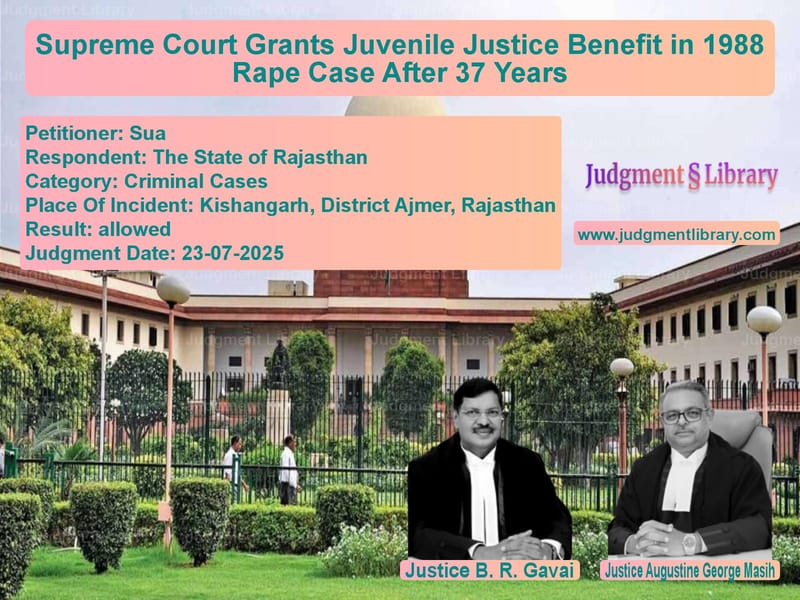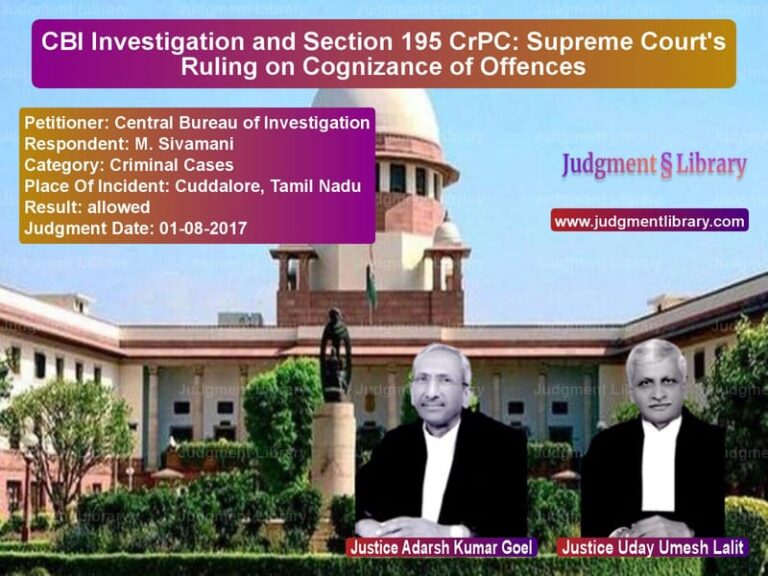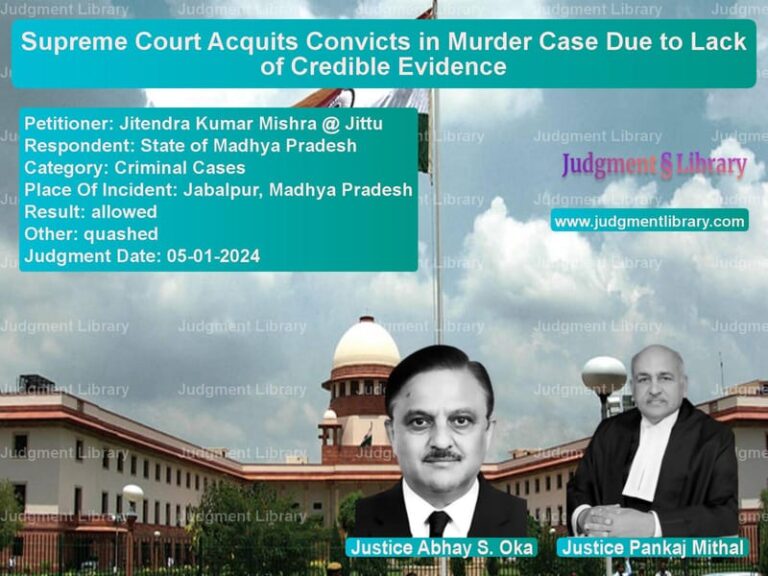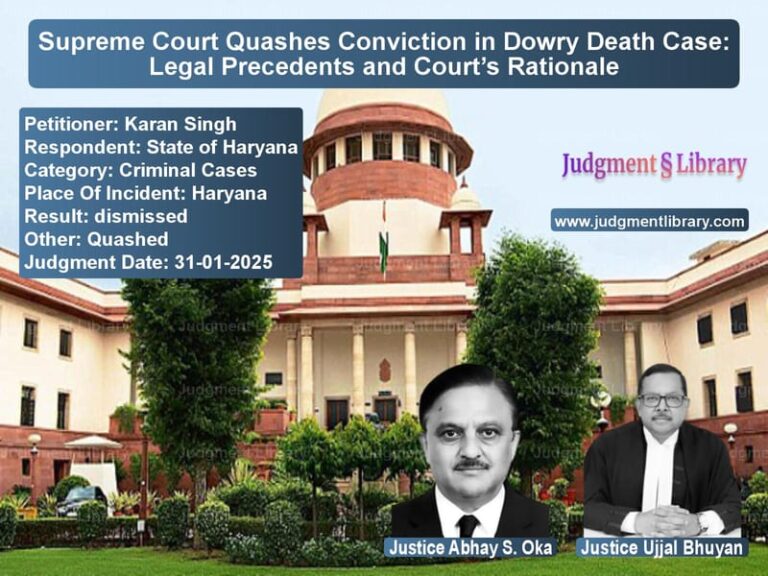Supreme Court Grants Juvenile Justice Benefit in 1988 Rape Case After 37 Years
In a landmark judgment that underscores the enduring nature of juvenile justice protections, the Supreme Court of India has set aside the sentence of a man convicted for a 1988 rape case after determining he was a juvenile at the time of the offense. The case, which has spanned nearly four decades of legal proceedings, highlights the crucial principle that claims of juvenility can be raised at any stage of judicial proceedings, even after conviction and sentencing.
The legal saga began on November 17, 1988, when an 11-year-old girl was allegedly raped in Kishangarh, District Ajmer, Rajasthan. According to the prosecution case, the victim had gone to fetch water from the school handpump around 2:00 PM when the incident occurred. The appellant was convicted under Section 342 (Wrongful Confinement) and Section 376 (Rape) of the Indian Penal Code by the Additional Sessions Judge, Kishangarh on February 2, 1993. He was sentenced to six months’ rigorous imprisonment for wrongful confinement and five years’ rigorous imprisonment for rape, along with fines. This conviction was subsequently upheld by the High Court on July 12, 2024.
The appellant’s counsel mounted a multi-pronged challenge to the conviction, arguing that “the First Information Report was registered after about 20 hours of the alleged occurrence of the incident.” They further pointed to significant contradictions in the prosecution case, noting that “the brother of the rape victim turned hostile and stated in categorical terms that no incident happened with his sister, rather, a false case was registered against the Appellant under the influence of their mother because of the boundary dispute of the enclosure with his family.”
Read also: https://judgmentlibrary.com/sc-st-act-misuse-prevention-supreme-court-quashes-false-atrocity-case/
The medical evidence also came under scrutiny, with the defense highlighting that “PW-8, the doctor who conducted the medical examination of the victim on the day following the incident… pointed out that there were no injuries on the external parts of the body. Although the hymen was torn horizontally, there was no fresh bleeding.” These discrepancies, the appellant argued, created reasonable doubt about the prosecution’s version of events.
However, the most significant argument emerged for the first time before the Supreme Court – the claim of juvenility. The appellant’s counsel asserted that “the Appellant-accused was a juvenile at the time of the alleged incident, which took place on 17.11.1988 at 2 o’clock in the afternoon. It is asserted that the date of birth of the Appellant is 14.09.1972, and therefore, on the date of the incident, his age would come to 16 years 2 months and 3 days.” The counsel argued that “the benefits can be claimed at any stage of the proceedings and even after the conclusion of the same,” relying on the Supreme Court’s earlier judgment in Dharambir v. State (NCT of Delhi).
The State of Rajasthan vigorously defended the conviction, arguing that the courts below had properly appreciated both oral and medical evidence. The prosecution detailed the circumstances of the case: “the victim was 11 years of age at the time of the incident when she had gone to the Bada after taking water from the school handpump on 17.11.1988 at about 2:00 PM, Appellant was already present in the Bada and was hiding behind the door. On the victim entering the Bada, he threw her down and committed rape upon her.”
The State provided a compelling explanation for the delay in filing the FIR: “Since she was an 11 year old child and was alone in her Bada, she waited for her mother to come, who came in the evening at about 5 PM when she narrated the entire story to her. Since in the month of November, the days are short and the police station was at a distance of 26 kms from the house of the victim. They could not approach the police for recording their complaint. Thus, it was in the morning, at around 8-9 AM, that the FIR was lodged at the police station.”
The prosecution also emphasized the corroborative evidence, noting that “the ghagra (long skirt) worn by the victim, as well as the underpants of the accused, which fortifies the commission of the offence” were recovered. Additionally, “the potency test of the accused-appellant was conducted by PW-12 Dr. Ramaprakash Garg, which established his capability of having sexual intercourse.”
On the legal question of relying solely on the victim’s testimony, the State cited settled jurisprudence: “a conviction can be sustained on the uncorroborated testimony of the prosecutrix if it is found to be credible and trustworthy. This principle was further reiterated in Proof Singh v. State of Madhya Pradesh and Ganesan v. State, where it was held that corroboration is not a sine qua non for conviction in sexual offence cases. Thus, the settled legal position is that the statement of the prosecutrix, if worthy of credence, requires no corroboration and can form the sole basis for conviction.”
Faced with the juvenility claim, the Supreme Court took a measured approach and ordered an inquiry. On January 20, 2025, the Court directed: “We, therefore, find that it would be appropriate that the District and Sessions Judge having jurisdiction at Kishangarh, Ajmer, Rajasthan conducts an inquiry into the claim of the petitioner, as to whether on the date of the commission of the offence, he was juvenile or not. The same shall be done in accordance with the guidelines laid down by this Court in the case of Abuzar Hossain v. State of West Bengal.”
The inquiry proved decisive. The Additional Sessions Judge examined school records, including “the admission record in Class-I of the Government Higher Secondary School, Baharu, dated 16.05.1980, as well as other school records where his date of birth is reflected as 14.09.1972 which has been accepted to be correct.” The inquiry conclusively established that “the findings with regard to his age at the time of commission of the offence has been returned as 16 years 2 months and 3 days on the date of the commission of the crime, i.e., 17.11.1988.”
Read also: https://judgmentlibrary.com/supreme-court-acquits-murder-accused-due-to-witness-credibility-issues/
The State’s objection that the juvenility plea was raised too late was firmly rejected by the Court, which relied on established precedent: “the plea of juvenility can be raised before any court and has to be recognized at any stage, even after disposal of the case. It has further been held that such a claim is required to be determined in terms of the provisions contained in the 2000 Act and the Rules framed thereunder, i.e., the 2007 Rules, even if the juvenile has ceased to be so on or before the date of commencement of the 2000 Act, as in the present case. The relevant factor, therefore, is that the accused, to be a juvenile, should have not completed 18 years of age on the date of commission of the offense.”
In its final ruling, the Supreme Court made a crucial distinction between conviction and sentence. While not overturning the conviction itself, the Court set aside the sentence, holding that “the provisions as contained in the 2000 Act would apply. Consequently, the sentence as imposed by the Trial Court and upheld by the High Court will have to be set aside, as the same cannot sustain.” The Court referred the matter to the Juvenile Justice Board for appropriate orders under Sections 15 and 16 of the Juvenile Justice Act, 2000, directing the appellant to appear before the Board on September 15, 2025.
This judgment reaffirms the protective philosophy of juvenile justice jurisprudence in India. By allowing the juvenility claim to be raised after nearly 37 years, the Supreme Court has emphasized that the benefits of juvenile justice legislation are substantive rights that persist regardless of when they are invoked. The case establishes that the clock stops for juvenility purposes on the date of the offense, and subsequent legal developments cannot deprive an accused of these protections.
The ruling also demonstrates the judiciary’s commitment to balancing the interests of justice for victims with the procedural safeguards meant to protect young offenders. While the Court did not disturb the findings of guilt by the trial court and High Court, it recognized that sentencing must comply with the specialized regime established for juveniles. This approach maintains the integrity of the conviction while ensuring that the sentencing process accounts for the accused’s developmental status at the time of the offense.
As the case now moves to the Juvenile Justice Board for fresh sentencing consideration, it serves as a powerful reminder of the enduring nature of legal protections for young offenders and the judiciary’s role in ensuring that technicalities of procedure do not override substantive justice.
Petitioner Name: Sua.Respondent Name: The State of Rajasthan.Judgment By: Justice B. R. Gavai, Justice Augustine George Masih.Place Of Incident: Kishangarh, District Ajmer, Rajasthan.Judgment Date: 23-07-2025.Result: allowed.
Don’t miss out on the full details! Download the complete judgment in PDF format below and gain valuable insights instantly!
Download Judgment: sua-vs-the-state-of-rajasth-supreme-court-of-india-judgment-dated-23-07-2025.pdf
Directly Download Judgment: Directly download this Judgment
See all petitions in Juvenile Justice
See all petitions in Criminal Defamation
See all petitions in Legal Malpractice
See all petitions in Other Cases
See all petitions in Judgment by B R Gavai
See all petitions in Judgment by Augustine George Masih
See all petitions in allowed
See all petitions in supreme court of India judgments July 2025
See all petitions in 2025 judgments
See all posts in Criminal Cases Category
See all allowed petitions in Criminal Cases Category
See all Dismissed petitions in Criminal Cases Category
See all partially allowed petitions in Criminal Cases Category







